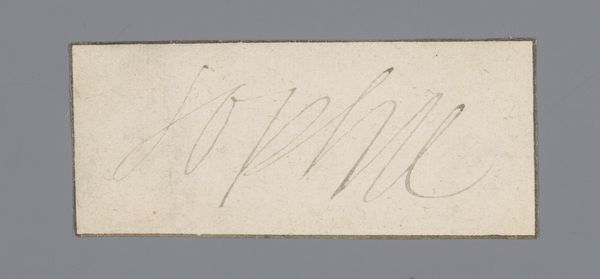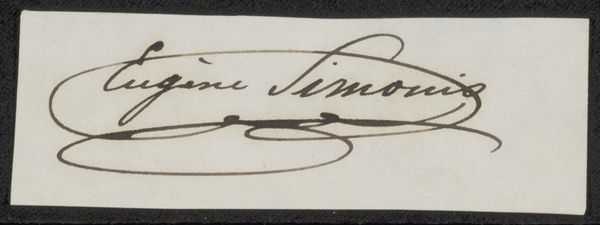
Handtekening van Caroline van Oranje-Nassau 1750 - 1800
0:00
0:00
Dimensions: height 2.2 cm, width 9.5 cm
Copyright: Rijks Museum: Open Domain
Curator: This elegant piece from between 1750 and 1800 is titled “Handtekening van Caroline van Oranje-Nassau,” which translates to "Signature of Caroline of Orange-Nassau." The Rijksmuseum holds this work, a drawing rendered with pen on paper. Editor: It's delicate. The light ink on paper, the graceful loops of the lettering… it almost whispers of secrets and privilege. It feels like peering into a very specific, rarefied world. Curator: Indeed. Caroline of Orange-Nassau was a significant figure. Consider her role as the daughter of the Prince of Orange and her marriage into the powerful Nassau family. A signature, then, becomes more than just a name; it’s a symbol of lineage, authority, and dynastic power. Editor: Absolutely. And the calligraphy itself—it’s a performance of identity. The deliberate flourish, the consistent hand—it speaks to the education and social expectations placed upon someone of her status. How conscious was she, do you think, of the statement she was making each time she signed her name? Curator: It’s tempting to see this signature through a modern lens, dissecting intention and performativity. However, it's essential to consider the conventions of the 18th century. Calligraphy was an integral part of education, particularly for women of noble birth. Editor: And yet, even within those conventions, there’s room for interpretation, isn’t there? The way the ink bleeds ever so slightly into the paper, or the almost unconscious variations in pressure...these tiny "errors" could be considered to be markers of authenticity, as a claim of identity in an age defined by constraints on female agency. Curator: A compelling interpretation! It underscores the value in continuously re-evaluating historical narratives and how we examine something as seemingly simple as a signature. Editor: It reminds us to read between the lines, literally, and to consider the complexities inherent in every historical object. What seems straightforward on the surface often has so much more beneath.
Comments
No comments
Be the first to comment and join the conversation on the ultimate creative platform.













